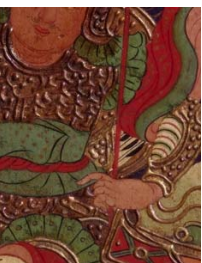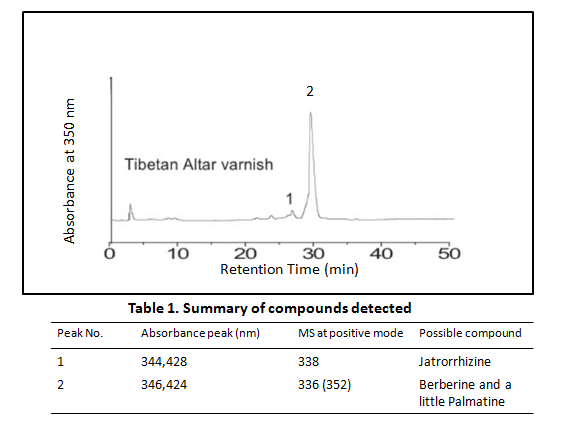PMA 2004-7, Tibetan Buddhist altar (19th to 20th century)
Information
In addition to Tangka, furniture plays an important role in worship in the Buddhist tradition.The buddhist altar collected by Philadelphia Museum of Art was originally built into the walls of a Tibetan home, most likely in a room reserved as a sacred space for daily ritual worship by Tibetan-Buddhist lay practitioners [1].
Photo accessed from Museum of Art online catalog
Summary of results
Small fragments from the top of the metallic decoration was removed, extracted and analyzed by Liquid chromatography-diode array detector-mass spectrometry (LC-DAD-MS). It was found that the altar door showing imitation gilding with berberine-toned brass flake, brass leaf and tin leaf. LC-DAD-MS analysis showed berberine [M+1 352] and palmatine [M+1 336] and jatrorrhizine [M+1 338], compounds found in barberry species. LC profiles of the altar colorant and Tibetan barberry (Berberis tibetacae) were similar. Detailed analytical results including pigments applied to the alter could be found in publications by B. Price [1] and X. Zhang [2].
HPLC profile
Identified compounds
References
[1] Price, B., Malenka, S., Sutherland, K., Paul, K., Kingery, A., and Zhang, X., A Tibetan Polychrome Domestic Altar and Four Six-Panel Cabinets: Materials Analysis, Dating, and Conservation. ICOM-CC, New Delhi, India, September, 919-925 (2008).
[2] Zhang, X., Mouri C., Mikage M., and Laursen, R. A., Identification of Sources of Protoberberine -Alkaloids Used as Yellow Dyes in Asian Objects of Historical Interest. Studies in Conservation 55 177-185 (2010).


